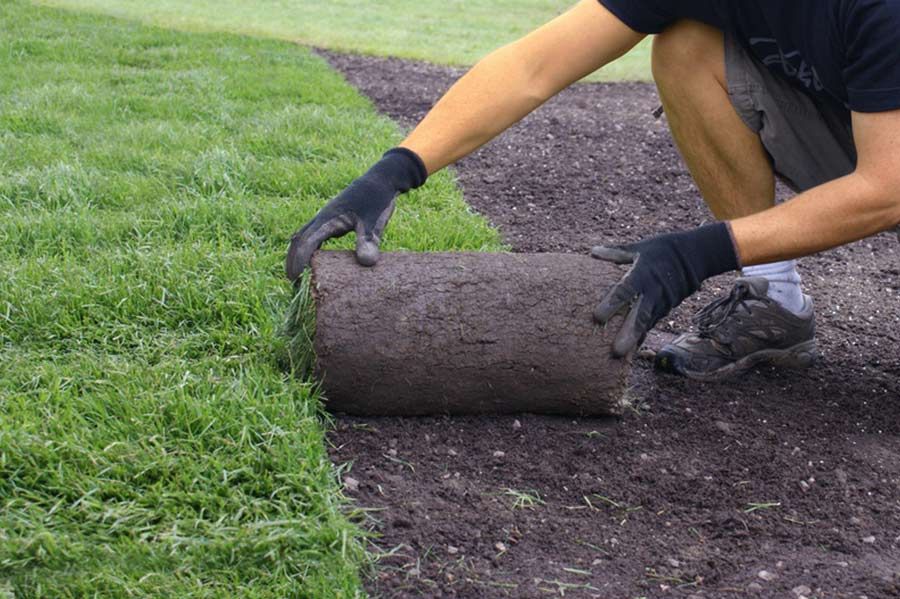Installing turf on a flat, level landscape is straightforward enough But when faced with an angled or hilly slope, successfully laying sod can seem daunting. Don’t let the incline intimidate you! With some adaptable techniques and smart preparation, you can create a lush, even lawn on sloped ground
Below I’ll share my best tips for properly laying and securing turf on slopes for a flawless finished product.
Prep the Slope for Success
Careful prep work makes turf installation far easier on angled terrain. Be sure to:
-
Remove all existing grass, weeds, roots and debris. Smooth and even the ground as much as possible
-
Loosen compacted soil to a depth of at least 6 inches to allow the sod’s roots to spread and embed.
-
Incorporate quality topsoil if needed to create a nutrient-rich turf base.
-
Install retaining walls, terracing or gradient systems if the slope is very steep. This creates sections that are easier to work with.
Fortify with Proper Base Materials
The right base under your turf provides crucial support and drainage:
-
A 2-3 inch layer of compacted gravel offers excellent slope stabilization.
-
Use a quality porous landscape fabric over the gravel to prevent soil loss.
-
For very steep areas, install horizontal supports like timber sleepers across the slope and anchor the turf to them.
Work Down the Slope
When laying your turf pieces, work your way down the incline row by row. This prevents slippage and lets excess water drain downwards.
-
Begin at the top laying lengthwise along the slope. Work side to side.
-
Place subsequent rolls slightly overlapping the previous row in a shingling effect.
-
On very steep slopes, secure edges and seams with long turf staples to prevent movement.
Secure the Perimeter
It’s critical to anchor the turf firmly around the entire outer slope perimeter to prevent slippage:
-
Bury edges in a trench around the border and stake them in place.
-
On steeper slopes, build a sturdy retaining border at the base to brace the bottom edge.
-
Consider commercial slope stabilization mesh products to provide structure and hold.
Finishing Touches
Once laid, gently rake the new turf and water it thoroughly to encourage rooting. Overseed any sparse areas to fill in. Finally, give your new sloped lawn a high-nitrogen fertilizer feeding to fuel quick establishment.
With the right preparation and installation techniques, even dramatically inclined terrain can support a flawless expanse of turf. Don’t be daunted by the slope – with a step-by-step approach and a bit of patience, you can successfully transform the space into a gorgeous lawn. Just take it slowly, work methodically, and don’t hesitate to ask for help wrangling the turf on steeper sections.
Expert Guide to Laying New Turf on a Slope
How do you lay turf on a lawn?
Start laying turf on the longest border. To create a straight edge, use a plank or a spirit level as a guide. If you’re creating a circular, oval or oddly shaped lawn, start in the middle and work out from there. When laying the next rolls of turf, make sure they’re closely butted together with the one you laid previously.
How do you lay sod on a slope?
To lay sod on a slope and get it to take root quickly, it’s important to keep the sod from slipping and provide it plenty of water and nutrients. To do so: Lay sod horizontally, with the “long” edge of the sod parallel to the slope. Use a lawn roller to remove air pockets from the sod. Use landscape staples to keep pieces of sod in place.
Can You Lay turf on a slope?
Turfing on a slope is a little bit more difficult than on a flat area. I give you details on how to prepare the surface, best practise for raking and grading, the best method to tread the soil and cut the edge into the existing lawn, laying and stitching turf together and butting up against new turf in the existing lawn.
How do you reshape a sloped lawn?
To do so: Lay sod horizontally, with the “long” edge of the sod parallel to the slope. Use a lawn roller to remove air pockets from the sod. Use landscape staples to keep pieces of sod in place. Fertilize sloped areas after laying sod. Water sloped parts of the yard more frequently, as they dry out more quickly.
- The Ultimate Guide to Growing Strawberries in Raised Beds - August 8, 2025
- No-Dig Garden Beds: The Easiest Way to Grow a Beautiful Garden - August 6, 2025
- How to Protect and Preserve Wood for Raised Garden Beds - August 6, 2025

